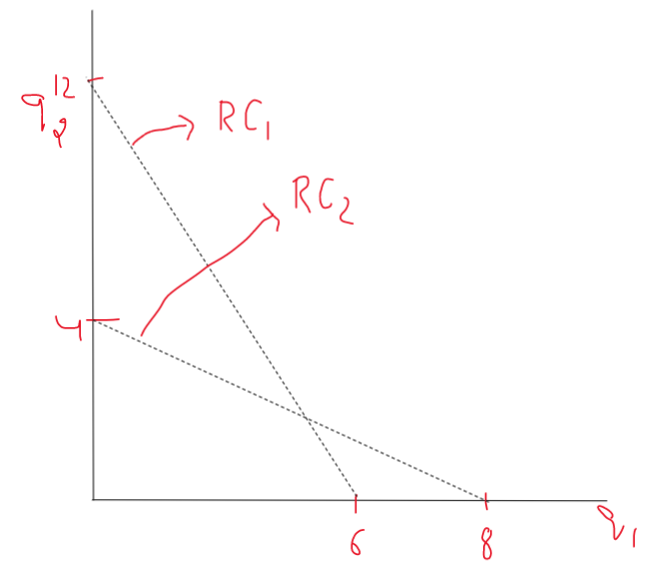Two firms compete in selling homogeneous goods. They choose their output levels q1 and q2 simultaneously and face demand curve P=80-6Q, where Q=q1+q2. The total cost function of firm 1 is C1=8q1 and the total cost function of firm 2 is
Two firms compete in selling homogeneous goods. They choose their output levels q1 and q2 simultaneously and face demand curve P=80-6Q, where Q=q1+q2. The total cost function of firm 1 is C1=8q1 and the total cost function of firm 2 is
Chapter1: Making Economics Decisions
Section: Chapter Questions
Problem 1QTC
Related questions
Question

Transcribed Image Text:Two firms compete in selling homogeneous
goods. They choose their output levels q1
and q2 simultaneously and face demand
curve P=80-6Q, where Q=q1+q2.
The total cost function of firm 1 is C1=8q1
and the total cost function of firm 2 is
C2=32q2+2/3.
a) Find and draw the reaction curves of the
two firms.
b) Compute equilibrium quantities, price
and profits.
Suppose now that firm 2, thanks to a
technological innovation, becomes more
efficient. The new total cost function of
firm 2 is C2=8q2
c) Compute the new equilibrium quantities,
price and profits.
Expert Solution
Given
We are given:

Step by step
Solved in 3 steps with 1 images

Knowledge Booster
Learn more about
Need a deep-dive on the concept behind this application? Look no further. Learn more about this topic, economics and related others by exploring similar questions and additional content below.Recommended textbooks for you


Principles of Economics (12th Edition)
Economics
ISBN:
9780134078779
Author:
Karl E. Case, Ray C. Fair, Sharon E. Oster
Publisher:
PEARSON

Engineering Economy (17th Edition)
Economics
ISBN:
9780134870069
Author:
William G. Sullivan, Elin M. Wicks, C. Patrick Koelling
Publisher:
PEARSON


Principles of Economics (12th Edition)
Economics
ISBN:
9780134078779
Author:
Karl E. Case, Ray C. Fair, Sharon E. Oster
Publisher:
PEARSON

Engineering Economy (17th Edition)
Economics
ISBN:
9780134870069
Author:
William G. Sullivan, Elin M. Wicks, C. Patrick Koelling
Publisher:
PEARSON

Principles of Economics (MindTap Course List)
Economics
ISBN:
9781305585126
Author:
N. Gregory Mankiw
Publisher:
Cengage Learning

Managerial Economics: A Problem Solving Approach
Economics
ISBN:
9781337106665
Author:
Luke M. Froeb, Brian T. McCann, Michael R. Ward, Mike Shor
Publisher:
Cengage Learning

Managerial Economics & Business Strategy (Mcgraw-…
Economics
ISBN:
9781259290619
Author:
Michael Baye, Jeff Prince
Publisher:
McGraw-Hill Education